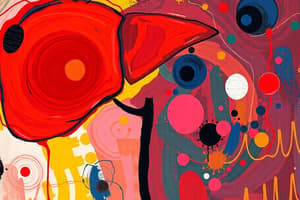Podcast
Questions and Answers
What is the term used to describe the yellowish discoloration of the sclerae, mucosae, and internal organs?
What is the term used to describe the yellowish discoloration of the sclerae, mucosae, and internal organs?
- Jaundice (correct)
- Bilirubinemia
- Cholestasis
- Hemolysis
Which of the following is responsible for the yellowish discoloration of the sclerae, mucosae, and internal organs?
Which of the following is responsible for the yellowish discoloration of the sclerae, mucosae, and internal organs?
- Biliverdin
- Bilirubin (correct)
- Urobilin
- Bile salts
What is a characteristic feature of a cell undergoing apoptosis?
What is a characteristic feature of a cell undergoing apoptosis?
- Abnormal nuclear shape
- Rapid cell division
- Shrinkage of the cell (correct)
- Increase in cell size
What is the most common cause of jaundice?
What is the most common cause of jaundice?
During which process is apoptosis a physiologic mechanism for cell removal?
During which process is apoptosis a physiologic mechanism for cell removal?
What is the result of apoptosis during menstruation?
What is the result of apoptosis during menstruation?
Which of the following organs is NOT typically affected by jaundice?
Which of the following organs is NOT typically affected by jaundice?
What is the term used to describe the breakdown of hemoglobin in the liver?
What is the term used to describe the breakdown of hemoglobin in the liver?
When does apoptosis typically occur?
When does apoptosis typically occur?
What is the role of apoptosis in embryogenesis?
What is the role of apoptosis in embryogenesis?
What is the initial response to injury that lasts for 3-5 seconds?
What is the initial response to injury that lasts for 3-5 seconds?
What is the result of progressive vasodilatation on local hydrostatic pressure?
What is the result of progressive vasodilatation on local hydrostatic pressure?
What is the term for the movement of leukocytes through the gaps between endothelial cells into the extravascular space?
What is the term for the movement of leukocytes through the gaps between endothelial cells into the extravascular space?
What is the result of slowing stasis of microcirculation?
What is the result of slowing stasis of microcirculation?
What is the clinical appearance of the presence of exudates?
What is the clinical appearance of the presence of exudates?
What occurs within 24 hours in the inflammatory response?
What occurs within 24 hours in the inflammatory response?
What is the primary function of proteolytic enzymes in the inflammatory response?
What is the primary function of proteolytic enzymes in the inflammatory response?
During the clearance phase, what type of cells are responsible for phagocytic activity?
During the clearance phase, what type of cells are responsible for phagocytic activity?
What is the result of the combined actions of proteolytic enzymes, autolytic enzymes, and macrophages in the clearance phase?
What is the result of the combined actions of proteolytic enzymes, autolytic enzymes, and macrophages in the clearance phase?
What process occurs simultaneously with the exudation of plasma, neutrophils, and some monocytes?
What process occurs simultaneously with the exudation of plasma, neutrophils, and some monocytes?
What type of embolism is characterized by the presence of air bubbles in the circulation?
What type of embolism is characterized by the presence of air bubbles in the circulation?
What is an example of a solid embolism?
What is an example of a solid embolism?
What is the term used to describe an embolus that is a clot?
What is the term used to describe an embolus that is a clot?
What is a possible cause of gaseous embolism?
What is a possible cause of gaseous embolism?
Which of the following can be an embolus?
Which of the following can be an embolus?
Flashcards are hidden until you start studying
Study Notes
Jaundice
- Excess accumulation of bilirubin causes yellowish discoloration of the sclerae, mucosae, and internal organs, known as jaundice.
Apoptosis
- Apoptosis is a physiologic process of cell removal during embryogenesis, menstruation, etc., characterized by cell shrinkage.
Hemodynamic Changes
- Transient vasoconstriction of arterioles lasts for 3-5 seconds, while severe injury can cause vasoconstriction for up to 5 minutes.
- Persistant progressive vasodilatation involves mainly arterioles, but also venules and capillaries, leading to increased local hydrostatic pressure and transudation of fluid into the extracellular space.
- Swelling occurs at the local site due to progressive vasodilatation.
- Slowing stasis of microcirculation causes increased blood cell concentration, raising blood viscosity.
- Leukocyte migration, mainly neutrophils, occurs along the vascular endothelium, with emigration into the extravascular space.
Inflammatory Response
- Acute inflammatory response occurs with exudation of plasma, neutrophils, and some monocytes within 24 hours.
- Combination of proteolytic enzymes, autolytic enzymes, and phagocytic activity of macrophages clears necrotic tissue, debris, and red blood cells.
Embolus
- Types of emboli include: • Thromboembolus • Platelets aggregates • Fragment of a tumor • Fat globules • Bubbles of air • Amniotic fluid • Infected foreign material
- Solid embolism: clot, tumor cells, bacterial clumps, or parasites
- Gaseous embolism: air bubbles in circulation due to opening of a large vein or sudden shift from high to low pressure.
Studying That Suits You
Use AI to generate personalized quizzes and flashcards to suit your learning preferences.




